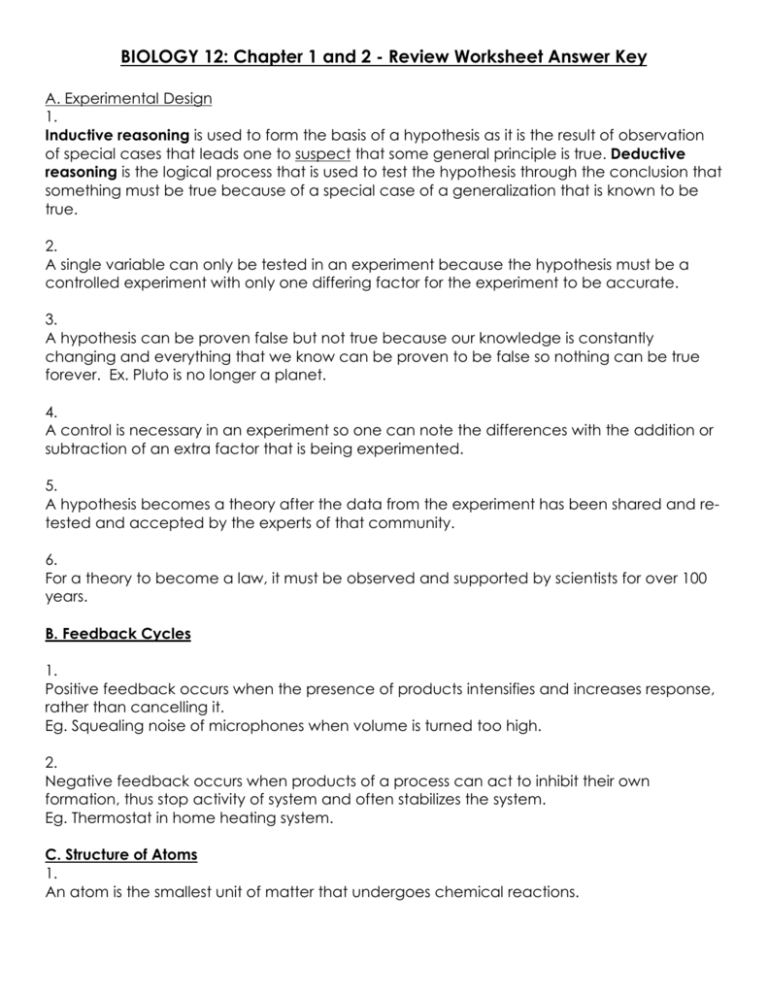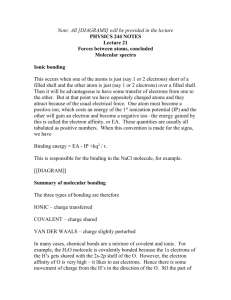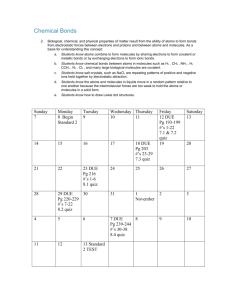Biology Chapter 1 & 2 Worksheet Answer Key
advertisement

BIOLOGY 12: Chapter 1 and 2 - Review Worksheet Answer Key A. Experimental Design 1. Inductive reasoning is used to form the basis of a hypothesis as it is the result of observation of special cases that leads one to suspect that some general principle is true. Deductive reasoning is the logical process that is used to test the hypothesis through the conclusion that something must be true because of a special case of a generalization that is known to be true. 2. A single variable can only be tested in an experiment because the hypothesis must be a controlled experiment with only one differing factor for the experiment to be accurate. 3. A hypothesis can be proven false but not true because our knowledge is constantly changing and everything that we know can be proven to be false so nothing can be true forever. Ex. Pluto is no longer a planet. 4. A control is necessary in an experiment so one can note the differences with the addition or subtraction of an extra factor that is being experimented. 5. A hypothesis becomes a theory after the data from the experiment has been shared and retested and accepted by the experts of that community. 6. For a theory to become a law, it must be observed and supported by scientists for over 100 years. B. Feedback Cycles 1. Positive feedback occurs when the presence of products intensifies and increases response, rather than cancelling it. Eg. Squealing noise of microphones when volume is turned too high. 2. Negative feedback occurs when products of a process can act to inhibit their own formation, thus stop activity of system and often stabilizes the system. Eg. Thermostat in home heating system. C. Structure of Atoms 1. An atom is the smallest unit of matter that undergoes chemical reactions. 2. Compare the protons, neutrons, and electrons by completing the following table. Subatomic Symbol Position Mass (a.m.u / Electrical Particle atomic mass Charge units) Electron Spins in orbit around 1/1800 -1 enucleus Proton Inside nucleus 1 +1 p Neutron Inside nucleus 1 0 n 3. The difference between the atomic number of an element and its atomic mass is that the atomic number added together with the number of neutrons is its atomic mass. 4. Instructions: Complete the table of atoms by filling in the missing number of protons (p), neutrons (n), electrons (e), and atomic mass (AM). Use your periodic table in your agenda as a reference if needed. ELEMENT Sodium # OF PROTONS 11 # OF ELECTRONS 11 # OF NEUTRONS 12 ATOMIC MASS 23 Carbon 6 6 6 12 Fluorine 9 9 10 19 Sulfur 16 16 16 32 Uranium 92 92 146 238 Silver 47 47 60 107 5. The carbon-12 isotope differs from the carbon-14 isotope in the number of neutrons that each has. Carbon-12 has 6 neutrons whereas carbon-14 has 8 neutrons and is radioactive when it decays. Radioactive isotopes are used as tracers in biochemical experiments, and used in various forms of imaging. 6. A molecule is a chemical unit of several atoms bonded together. A compound is made up of 2 or more different elements. 7. The octet rule determines where an electron is located in an element’s orbitals. Inner orbital can hold a maximum of 2 electrons, afterwards all orbitals can hold a maximum of 8 electrons. The exception to the rule is that Hydrogen only has 1 electron so it can only have 1 electron in its orbital. 8. The sodium ion carries a positive charge of +1 because it only has one electron in its outermost orbital and it is easier to give up an electron rather than gain 7 electrons to become stable. Losing one electron gives it a charge of positive 1. 9. The chlorine ion carries a negative charge of -1 because it already has 7 electrons in its outermost orbital so it is easier for it to gain just one more negatively charged electron to become stable. 10. An ionic bond forms between a positively charged ion and a negatively charged ion like Na+ and Cl-. It forms when an ion needs a certain number of electrons and joins with another ion that needs to give up that certain number of electrons. D. Covalent Bonding 1. Covalent bonds occur when non-metals join nonmetals and atoms share electrons. 2. There are 2 hydrogen atoms in one molecule of water. 3. There is 1 oxygen atom in one molecule of water. 4. 2 electrons are shared in a water molecule. 5. Covalent bond. 6. Water is a polar molecule. 7. The shared electrons of a water molecule tends to spend more time in oxygen. 8. Hydrogen bonds are formed between water molecules due to this phenomenon. 9. Structural formula use straight lines to show the covalent bonds between atoms. Molecular formula only indicate the number of each type of atom making up a molecule. 10. Double bond is where atoms share 2 pairs of electrons. Triple bond is where atoms share 3 pairs of electrons. Both these bonds are very strong. 11. Ice floats on water because solid water is less dense than its liquid form. This is beneficial for aquatic organisms because it means they can survive even in the cold winters as water will not freeze completely in the lake, only on the top, and acts as an insulator, the bottom is still livable. E. pH 1. Acids dissociate in water, releasing H+ ions. Bases either take up H+ ions or release OH- ions. 2. pH less than 7 are acidic. pH greater than 7 are basic. As pH decreases, there is a 10-fold increase in [H+ ions] for each pH unit. 3. A buffer is a chemical or combination of chemicals that take up excess H+ or OH- to help keep pH constant. Salt consists of positive ion of the base and negative ion of the acid from another monomer forming H2O molecules. Answers to 4, 5, 6 = refer to textbook/notes. F. SYNTHESIS: A CHEMICAL REACTION A chemical reaction involves the rearrangement of chemical bonds with a release or absorption of energy. The process of cellular respiration uses the oxygen we breathe and glucose (a carbohydrate in our diet), and produces energy plus the waste products carbon dioxide and water. The chemical reaction for cellular respiration is: C6H12O6 (glucose) + 6O2 6CO2 + (oxygen) (carbon dioxide) 6H2O (water) + Energy (chemical) Study the equation, and answer questions 1 through 4. 1. Glucose and oxygen 2. CO2 and Water 3. Fill out the table. Molecule/Compound Number of Molecules in Rxn C6H12O6 1 O2 6 CO2 6 H2O 6 4. Compare the number of atoms of each element on each side of the arrow by completing the following table below. Left Side Number of carbon atoms Number of oxygen atoms Number of hydrogen atoms 6 18 12 Right Side 6 18 12 Examine the chemical equation for photosynthesis below and use it to answer questions 5 and 6. Energy (Light) + 6CO2 + 6H2O C6H12O6 (glucose) + 6O2 5. How do the chemical equations for cellular respiration and photosynthesis compare? They reverse to form the other. Ie photosynthesis reversed is the equation for cellular respiration. 6. How many molecules of glucose would be produced from 24 molecules of carbon dioxide? 4 molecules of glucose can be produced. G. Organic Molecules 1. Organic molecules. 2. Dehydration synthesis: when (H) from a monomer bonds with (OH) from another monomer forming H2O molecules. Dehydration hydrolysis: with H2O molecules, one monomer takes an (H) and adjacent monomer takes an (OH). 3. Monosaccharides: 1 sugar molecules classified by # of carbons Disaccharides: 2 sugar molecules Polysaccharides: Many sugars 4. Monosaccharides: ribose (5C), glucose (6C) Disaccharides: maltose (glucose + glucose) Polysaccharides: starch(chains of glucose)-store glucose in plants, glycogen (chains of gluose)-store glucose in animals 5. Starch: storage form of glucose in plants Glycogen: storage form of glucose in animals Cellulose in cells: in plant cell walls 6. Humans are unable to digest cellulose because humans do not have the digestive enzymes to break down the cellulose linkages. 7. a) Lipids are not soluble in water. b) Formation: 1 glycerol molecule and 3 fatty acids. 8. Fats: (Lard) used for long-term energy storage, insulation and a cushion for organs Oils: (corn oil) are liquid at room temp. 9. Saturated Fatty Acids: no double bonds between C atoms eg. Butter Unsaturated Fatty Acids: double bonds b/w C atoms eg Vegetable Oil 10. a) Emulsification: dispersing a liquid into another b) Soap: salt formed from fatty acid + inorganic base, it causes oil to disperse in water b/c nonpolar ends project into the fat droplet and polar ends project outward. 11. Phospholipid bilayer in cell membrane has heads facing outward and tails facing each other to repel water. 12. Steroid structures unique b/c has backbone of 4-C rings eg. Cholesterol, aldosterone, estrogen and testosterone 13. Proteins have structural function ie. Hair, nails, cartilage They are enzymes, contribute to chemical workings of the body. 14. Functional groups are: amino (NH2) group, acid (COOH) group, and Remainder (R ) group. 15. Differ by their R group. 16. Peptide bonds join 2 amino acids together. In dehydration synthesis acid group of one aa reacts w/ amino group of another aa and water is released. 17. Secondary level. 18. Covalent bonds are present and they occur between R groups. 19. DNA and RNA, human genes composed of DNA. 20. Every nucleotide has: Phosphate ion, 5-C sugar and nitrogen base. DNA is double-stranded, strands held together by hydrogen bonding b/w bases. RNA is single-stranded. 21. a) Deoxyribose b) Ribose 22. Through hydrolysis, one inorganic phosphate is broken off from ATP and energy is released for the cell to use.








